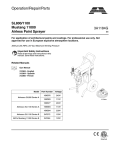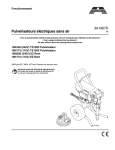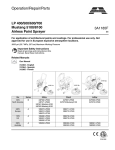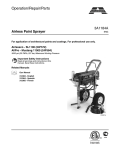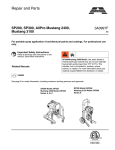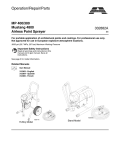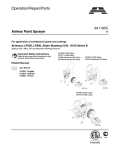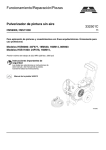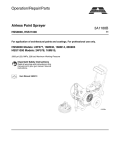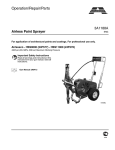Download AIRLESSCO SL 6250 Instruction manual
Transcript
Operation/Repair/Parts 3A1187E Airless Paint Sprayer EN For application of architectural paints and coatings. For professional use only. Airlessco - GS6250 (24F575), (16M532) 3000 psi (20.7 MPa, 207 bar) Maximum Working Pressure Important Safety Instructions Read all warnings and instructions in this manual. Save these instructions. Related Manuals Gun Manual Model 24F575 Model 16M532 312363 312364 312365 3A0413 ti15986a Warnings Warnings The following warnings are for the setup, use, grounding, maintenance, and repair of this equipment. The exclamation point symbol alerts you to a general warning and the hazard symbols refer to procedure-specific risks. When these symbols appear in the body of this manual, refer back to these Warnings. Product-specific hazard symbols and warnings not covered in this section may appear throughout the body of this manual where applicable. WARNING WARNING FIRE AND EXPLOSION HAZARD Flammable fumes, such as solvent and paint fumes, in work area can ignite or explode. To help prevent fire and explosion: • Use equipment only in well ventilated area. • Do not fill fuel tank while engine is running or hot; shut off engine and let it cool. Fuel is flammable and can ignite or explode if spilled on hot surface. • Eliminate all ignition sources; such as pilot lights, cigarettes, portable electric lamps, and plastic drop cloths (potential static arc). • Keep work area free of debris, including solvent, rags and gasoline. • Do not plug or unplug power cords, or turn power or light switches on or off when flammable fumes are present. • Ground all equipment in the work area. See Grounding instructions. • Use only grounded hoses. • Hold gun firmly to side of grounded pail when triggering into pail. • If there is static sparking or you feel a shock, stop operation immediately. Do not use equipment until you identify and correct the problem. • Keep a working fire extinguisher in the work area. SKIN INJECTION HAZARD High-pressure spray is able to inject toxins into the body and cause serious bodily injury. In the event that injection occurs, get immediate surgical treatment. • Do not aim the gun at, or spray any person or animal. • Keep hands and other body parts away from the discharge. For example, do not try to stop leaks with any part of the body. • Always use the nozzle tip guard. Do not spray without nozzle tip guard in place. • Use Airlessco nozzle tips. • Use caution when cleaning and changing nozzle tips. In the case where the nozzle tip clogs while spraying, follow the Pressure Relief Procedure for turning off the unit and relieving the pressure before removing the nozzle tip to clean. • Do not leave the unit energized or under pressure while unattended. When the unit is not in use, turn off the unit and follow the Pressure Relief Procedure for turning off the unit. • Check hoses and parts for signs of damage. Replace any damaged hoses or parts. • This system is capable of producing 3000 psi. Use Airlessco replacement parts or accessories that are rated a minimum of 3000 psi. • Always engage the trigger lock when not spraying. Verify the trigger lock is functioning properly. • Verify that all connections are secure before operating the unit. • Know how to stop the unit and bleed pressure quickly. Be thoroughly familiar with the controls. 2 3A1187E Warnings WARNING WARNING EQUIPMENT MISUSE HAZARD Misuse can cause death or serious injury. • Always wear appropriate gloves, eye protection, and a respirator or mask when painting. • Do not operate or spray near children. Keep children away from equipment at all times. • Do not overreach or stand on an unstable support. Keep effective footing and balance at all times. • Stay alert and watch what you are doing. • Do not leave the unit energized or under pressure while unattended. When the unit is not in use, turn off the unit and follow the Pressure Relief Procedure for turning off the unit. • Do not operate the unit when fatigued or under the influence of drugs or alcohol. • Do not kink or over-bend the hose. • Do not expose the hose to temperatures or to pressures in excess of those specified by Airlessco. • Do not use the hose as a strength member to pull or lift the equipment. PRESSURIZED ALUMINUM PARTS HAZARD Use of fluids that are incompatible with aluminum in pressurized equipment can cause serious chemical reaction and equipment rupture. Failure to follow this warning can result in death, serious injury, or property damage. • Do not use 1,1,1-trichloroethane, methylene chloride, other halogenated hydrocarbon solvents or fluids containing such solvents. • Many other fluids may contain chemicals that can react with aluminum. Contact your material supplier for compatibility. MOVING PARTS HAZARD Moving parts can pinch, cut or amputate fingers and other body parts. • Keep clear of moving parts. • Do not operate equipment with protective guards or covers removed. • Pressurized equipment can start without warning. Before checking, moving, or servicing equipment, follow the Pressure Relief Procedure and disconnect all power sources. CARBON MONOXIDE HAZARD Exhaust contains poisonous carbon monoxide, which is colorless and odorless. Breathing carbon monoxide can cause death. • Do not operate in an enclosed area. TOXIC FLUID OR FUMES HAZARD Toxic fluids or fumes can cause serious injury or death if splashed in the eyes or on skin, inhaled, or swallowed. • Read MSDSs to know the specific hazards of the fluids you are using. • Store hazardous fluid in approved containers, and dispose of it according to applicable guidelines. 3A1187E 3 Warnings WARNING WARNING BURN HAZARD Equipment surfaces and fluid that’s heated can become very hot during operation. To avoid severe burns: • Do not touch hot fluid or equipment. PERSONAL PROTECTIVE EQUIPMENT You must wear appropriate protective equipment when operating, servicing, or when in the operating area of the equipment to help protect you from serious injury, including eye injury, hearing loss, inhalation of toxic fumes, and burns. This equipment includes but is not limited to: • Protective eye wear, and hearing protection. • Respirators, protective clothing, and gloves as recommended by the fluid and solvent manufacturer. 4 3A1187E Component Identification Component Identification C PRIME ti14792a ti16292a PRESSURE B A ti16293a NOTE: The valve handle can move both clockwise and counter clockwise and can face different directions. A Pressure Control Knob Adjusts pressure. Turn clockwise to increase pressure and counterclockwise to decrease pressure. Prime/Pressure (PR) Relief Valve Primes pump and relieves pressure from gun, hose and tip. B Prime/Pressure (PR) Relief Valve Open Position Relieves pressure from gun, hose and tip and primes the unit when in the open position. It is in the Open position when there is a wider gap between valve handle and cam body. C Prime/Pressure (PR) Relief Valve Closed Position Pressurizes system when closed. It is in the Closed position when there is only a slight gap between handle and body. Turn to the closed position to spray. 3A1187E 5 Operation Operation Pressure Relief Procedure NOTE: If you suspect that pressure hasn’t been relieved due to damaged Prime/Pressure Relief Valve, or other reason, slowly loosen the tip nut or hose coupling. To reduce risk of injury, follow this pressure relief procedure whenever you see this symbol throughout this manual, Also, perform this procedure whenever you: • Stop spraying • Check or repair any part of this system • Install or clean spray nozzle ti16293a 1. Engage the gun trigger lock. Refer to the separate instruction manual provided with gun for safety features and how to engage the trigger lock. Setup 2. Turn the unit off. 3. Disengage the gun trigger lock and trigger the gun to relieve residual fluid pressure. Hold metal part of the gun in contact with grounded metal pail. Use minimum pressure. Grounding Always ground the following components: • Sprayer - Connect a ground wire and clamp (supplied) to a true earth ground. • Fluid Hose - Use only grounded hoses. • Spray Gun of Dispensing Valve - Grounding is obtained through connection to a properly grounded fluid hose and pump. • Object being sprayed - According to local code. ti15989a 4. Turn Prime/Pressure Relief Valve (PR Valve) to the open (priming) position to relieve residual pressure. 5. Re-engage gun trigger lock and close Prime/Pressure Relief Valve. If the spray tip or hose is clogged, follow Steps 1 through 5 above. Expect paint to splash into the bucket while relieving pressure during Step 4. Connect the hose and gun 1. Remove the plastic cap plug from the outlet and screw a conductive or grounded 3000 psi spray hose onto fluid outlet. 2. Connect an airless spray gun to the other end of the hose. Do not install spray tip. NOTE: Do not use thread sealer on swivel unions as they are made to self seal. NOTE: The 6’ whip hose should always be 3/8”. 6 3A1187E Operation Fill the Packing Nut/Wet Cup • 1. Fill the Packing Nut/Wet Cup 1/3 full with Airlessco Throat Seal Oil (TSO). ti15987a When changing from oil based material to water base material, flush with mineral spirits solvent (also called white spirit), followed by soapy water, then a clean water flush. • When flushing with solvents, ground pail and gun. • Flush before changing colors, before fluid can dry in the equipment, at the end of the day, before storing, and before repairing equipment. Flushing Check the Engine Oil Level 1. Unscrew the oil fill plug. The dipstick is attached to the plug. 2. Without threading the plug into place, check to be sure the oil is up to the top mark of the dipstick. 3. If oil is needed, refer to engine manual. Fill the Fuel Tank 1. Close the fuel shutoff valve. 2. Use only clean, fresh, well-known brands of unleaded regular grade gasoline. • To reduce the risk of static sparking, which can cause fire or explosion. Always hold a metal part of the gun firmly against the metal pail when flushing. This also reduces splashing. • Always remove the spray tip before flushing. • Only metal pails, which are conductive, should be used as solvent pails when flushing. 1. Make sure the gun trigger lock in engaged and there is no spray tip in the gun. Refer to the separate instruction manual provided with gun for safety features and how to engage the trigger lock. 3. Remove the fuel cap and fill tank. Be sure the air vent in the fill cap is not plugged so fuel can flow to the carburetor, then replace the cap. Prime and Flush Storage Fluid ti16028a NOTICE The equipment was tested with lightweight oil, which is left in the fluid passages to protect parts. To avoid contaminating your fluid with oil, flush the equipment with a compatible solvent before using the equipment for the first time. Before beginning a new spraying project you need to prime the sprayer and flush the storage fluid out of the sprayer. 2. Pour enough clean, compatible solvent into a large, empty metal pail to fill the pump and hoses. 3. Place the suction tube into the pail or place the pail under the pump. 4. Turn Pressure Control Knob to low. Oil- or Water-based Materials • When changing from water-based material to oil based material, flush with soapy water and then mineral spirits solvent (also called white spirit). PRIME HIGH PRESSURE ti17939a PRESSURE 3A1187E 7 Operation 5. Open the prime valve to the open - “Priming Position”. This will allow an easy start. Open (Priming and Pressure Relief) 12. Disengage the gun trigger lock and squeeze the gun trigger. At the same time, slowly turn the pressure control knob clockwise, just enough to move liquid at low pressure. 13. Allow the pump to operate until clean solvent comes from the gun. ti16293a 14. Release the trigger and engage the gun trigger lock. 6. Turn the engine ON/OFF switch to ON. 7. Move the choke toward the closed position. 8. Move the throttle lever slightly to the left. 9. Turn the fuel valve ON. Pull the start rope. Pull the engine over against compression stroke and then let the rope rewind slowly into the starter. Pull firmly and rapidly to start the engine. Do NOT drop the rope. Hold on to the handle while rewinding, or the rope may rewind improperly and jam the assembly. If the engine does not start, open the choke a little more. If the engine floods, open the choke all the way and continue cranking. 15. If you are going to start spraying, place the pump or suction tube into the supply container. Release the gun trigger lock and trigger the gun into another empty, metal container, holding a metal part of the gun firmly against the metal pail, forcing the solvent from the pump and hose. When paint starts coming from gun, turn pressure control knob to minimum pressure, place prime valve in prime (open) position and engage the gun trigger lock. 16. If you are going to store the sprayer, remove the suction tube or pump from the solvent pail, force the solvent from the pump and hose. Engage the gun trigger lock. See Storage, 10. 17. Whenever shutting down the sprayer, follow Pressure Relief Procedure, page 6. NOTICE Throttle Lever Choke Lever ti14793a Fuel Valve 10. After the engine is warm, gradually close the choke, raise the RPM of engine slightly by moving throttle to the left. Close the prime valve. Closed (Pressure) To prevent damage and freezing during storage, never leave water in the fluid pump Startup 1. Prepare the material according to the material manufacturer’s recommendations. 2. Place pump or suction tube into the material container. 3. Start the sprayer. ti15988a 11. Point the gun into the metal pail and hold a metal part of the gun firmly against the pail. Maintain firm metal to metal contact between gun and container. ti10312a 8 a. Prime Valve must be “OPEN” in the priming position. b. Pressure Control Knob must be in low pressure. c. Turn the engine ON/OFF switch to ON. d. Move the choke toward the closed position. e. Move the throttle lever slightly to the left. f. Turn the fuel valve ON. Pull the start rope. Pull the engine over against compression stroke and then let the rope rewind slowly into the 3A1187E Operation starter. Pull firmly and rapidly to start the engine. Do NOT drop the rope. Hold on to the handle while rewinding, or the rope may rewind improperly and jam the assembly. If the engine does not start, open the choke a little more. If the engine floods, open the choke all the way and continue cranking. g. After the engine is warm, gradually close the choke, raise the RPM of engine slightly by moving throttle to the left. Close the prime valve. h. Point the gun into the metal pail and hold a metal part of the gun firmly against the pail. Maintain firm metal to metal contact between gun and container. i. Disengage the gun trigger lock and squeeze the gun trigger. At the same time, slowly turn the pressure control knob clockwise, just enough to move liquid at low pressure. 4. Prime the pump. NOTICE Do not start engine without fluid pump having enough fluid so that it can be primed. Running fluid pump dry will decrease life of the pumps packings. a. Allow pump to operate until paint comes from gun. b. Release the trigger and engage the gun trigger lock. c. Turn Prime Valve OPEN to the prime position ensuring the pressure is released from the system. d. Turn Pressure Control Knob to minimum pressure. e. Install spray tip onto gun. f. Close the prime valve to the pressure position. g. Turn the pressure control knob to desired spray pressure. h. Disengage the gun safety lock and you are ready to start spraying. NOTE: If you spray into the paint bucket, always use the lowest spray pressure and maintain firm metal to metal contact between gun and container. 3A1187E Adjust the Pressure • To reduce the risk of injection, never hold your hand, body, fingers or hand in a rag in front of the spray tip when cleaning or checking for a cleared tip. Always point the gun toward the ground or into a waste container when checking to see if the tip is cleared or when using a self cleaning tip. • To stop the unit in an emergency, turn the engine off. Then relieve the fluid pressure in the pump and hose. See Pressure Relief Procedure, page 6 When adjusting the pressure, turn the Pressure Control Knob clockwise to increase pressure and counterclockwise to decrease pressure. Always use the lowest pressure necessary to completely atomize the material. If more coverage is needed, use a larger tip rather than increasing the pressure. Check the spray pattern. The tip size and angle determines the pattern width and flow rate. NOTICE NOTE: Operating the sprayer at higher pressure than needed wastes material, causes early tip wear, and shortens sprayer life. Shutdown 1. Relieve Pressure, page 6. 2. Clean the tip and gun as recommended in the separate Gun Manual supplied with the gun. 3. If spraying water-based material or a material that could harden in the sprayer overnight, flush the sprayer after use. See Flushing, page 7. NOTE: To stop the unit in an emergency, turn the engine off. Then relieve the fluid pressure in the pump and hose. See Pressure Relief Procedure, page 6 9 Operation Storage Short Term Start Up After Storage 1. Flush sprayer with compatible solvent before storing, then fill the pump and hoses with an oil based solvent such as mineral spirits solvent (also called white spirit) or Graco or Airlessco Pump Armor. Before using water-base paint, flush sprayer with soapy water and then a clean water flush. When using oil-base paint, flush out the mineral spirits solvent (also called white spirit) with the material to be sprayed. • • For oil base paint: flush with mineral spirits solvent (also called white spirit) For water-base paint: flush with water, then mineral spirits solvent (also called white spirit) and leave the pump, hose and gun filled with mineral spirits solvent (also called white spirit). NOTE: Always store unit indoors. Long Term For longer storage, use Graco or Airlessco Pump Armor. Shut off sprayer, Relieve Pressure, page 6, and make sure prime valve is left open. 10 3A1187E Maintenance Maintenance Daily Maintenance Regular Maintenance Keep displacement pump packing nut/wet cup lubricated with Airlessco Throat Seal Oil at all times. The TSO helps protect the packings and rod. Inspect the packing nut daily. If seepage of paint into the packing nut and/or movement of the piston upward is found (while not spraying), the packing nut should be tightened just enough to stop leakage. Overtightening will damage the packings and reduce the packing life. 1. Always stop the pump at the bottom of its stroke when you take a break or at the end of the day. This helps keep material from drying on the rod, damaging the packings. 2. Keep the displacement pump packing nut/wet cup 1/3 full of Airlessco Throat Seal Oil (TSO) at all times. The TSO helps protect the packings and rod. 3. Lubricate Connecting Rod Pin every 3 months. Cleaning a Clogged Tip Oil and Lubrication Instructions Bleed (Weep Hole) 1. Relieve Pressure, page 6. Sealed Bearing 1 oz. SAE 30W Oil semi-annually 2. Clean the front of the tip frequently (with toothbrush only) during the day to keep material from building up and clogging the tip. 3. To clean and clear a tip if it clogs, refer to the separate instruction manual received with your gun and nozzle. 4. Clean a clogged standard flat tip only after the tip is removed from the gun. Reducing Clutch Wear 1. The first 50 feet of airless spray hose should be 3/8”, the larger diameter works as a pulsation damper and saves unnecessary cycling the clutch. A minimum of 100 feet of hose should be used. 2. Adjust the Engine Speed and Pump Pressure. First set the throttle lever to the maximum RPM setting (fully left). Trigger the gun onto a test paper to check the spray pattern and atomization. Adjust the Pressure Control Knob until you get a good pattern. Reduce RPM of engine to support pressure without laboring engines. Oil impregnated sleeve - dip in hot 10W oil when removed Fill plug- unit has grease in gearbox from factory and will not require changing. (Grease - PN 301178) ti15992a Servicing the Fluid Pump Fluid Pump Disconnect 1. Flush the material you are spraying, if possible. 2. Relieve Pressure, page 6. Stop the pump in the middle of down stroke. 3. Remove the suction tube and fluid hose (if so equipped) from the fluid pump. 4. Remove the connecting rod shield from the pump. 3A1187E 11 Maintenance 5. Remove two retaining rings (4) and slip the sleeve of the coupling down and remove both coupling halves. This will disconnect fluid pump from the connecting rod. 2. Insert one of the retaining rings through the packing nut and rest the sleeve on top of it. 6. Using a 7/8” box wrench disconnect the high pressure fluid line from the pump. 7. Using a 9/16” wrench, unscrew the two tie rod locknuts (10). 8. Pull the pump off the tie rods. ti15995a ti15996a 3. Connect the connecting rod with the fluid pump by installing the coupling halves. Slide sleeve over the coupling halves and secure with retaining ring. 1 2 3 ti15997a 5 12 4 4. Remove the retaining ring from the packing nut and insert into coupling halves. 6 13 8 11 10 ti15998a 9 ti15993a 5. Secure the fluid pump housing to the tie rods and screw locknuts with washers on loosely. Fluid Pump Reinstall 6. Tighten the tie rod locknuts evenly to 30 ft. lb. 1. Loosen the packing nut and extend piston rod to fully up position. NOTE: After all the rod locknuts are tight, the alignment of both rods should allow easy assembly and disassembly of the coupling. If any binding, loosen and retighten all the rod locknuts to improve the alignment. Misalignment causes premature wear of seal and packings. 7. Tighten packing nut clockwise until resistance against the packings can be felt. Turn it one full turn more. ti15994a 12 3A1187E Maintenance 8. Start the pump and operate it slowly (at low engine speed) to check the piston rod for binding. Adjust tie rod lock nuts if necessary to eliminate binding. Servicing the Outlet Valve 1. Complete all steps of the Fluid Pump Disconnect, page 11. 9. Prime the unit and run at maximum pressure for several minutes, then release the pressure and repeat step 7. 2. Screw the suction nut off the pump and remove inlet valve assembly. 10. Fill the wet cup (packing nut) with five drops of TSO (Throat Seal Oil). 3. Using the rod collar tool, loosen the packing nut and push the piston (13) down and out of the fluid body. Servicing the Inlet and Outlet Valves Disassembly of the Outlet Valve 1. Using the rod collar tool (189211), screw the suction nut (7), containing intake seat support, off of the fluid body. 2. Remove the inlet seat (4), O-ring, inlet ball (3) and inlet retainer (2) with O-ring. 3. Clean all parts and inspect them for wear and damage, replacing parts as needed. Old O-rings should be replaced with new ones. NOTE: Inlet Seat (867574) is reversible. 4. Clean inside of fluid body. 5. Reassemble the valve and screw it onto the fluid body if no further service is needed. 4. Place piston holder (866058) in a vise. Slide piston (13) into holder and lock in place with a 1/4” pin (867166). 5. Clean all parts and inspect them carefully for wear or damage. Inspect the outside of the piston rod for scoring or wear. Replace these parts if needed. A worn piston rod will cause premature wear of packings. 6. Using 3/8” allen wrench to unscrew retainer (8) from piston (13). 7. Remove outlet seat (9), O-ring, outlet ball (11) and outlet retainer (12). 8. Inspect outlet ball (11) and seat for wear. Replace as required. NOTE: Outlet Seat (867575) is reversible. 9. Install parts back into piston rod. Place two drops of loctite No. 242 (blue) on threads of the retainer (8) before assembling and torque to 20 ft-lbs. 8 1 9 10 11 2 12 13 3 4 5 867166 6 866058 7 ti15999a 3A1187E ti16000a 13 Maintenance Packing Replacement Procedures Disassembly of the Fluid Pump Reassembly of the Fluid Pump 1. Unscrew and remove the packing nut. 1. Take the lower metal male gland and place it down on the flat side. 2. Push the piston rod down through the packings and out of the pump. 3. Now push the packing removal tool up through the pump and remove the top bringing the packings, spacer and springs along with it, leaving the fluid body empty. NOTE: Make sure all packings and glands have been removed from the fluid pump. 2. Take three of the lower polyethylene V-packings and tow of the leather V-packings and place onto the male gland, with the inverted side down, in the following order: • • • • • Polyethylene Leather Polyethylene Leather Polyethylene 4. Clean inside of fluid body. 5. Disassemble all parts and clean for reassembly. Discard any old packings. Save the metal upper glands. Replace metal lower glands with new metal glands from the packing kit. NOTE: If the old packing had a metal gland, discard and replace with a new plastic one from packing kit. 6. Lubricate leather packing in lightweight oil for 10 minutes prior to reassembly. 7. Unscrew and remove the packing nut. 8. Push the piston rod down through the packings and out of the pump. 9. Now push the packing removal tool up through the pump and remove from the top bringing the packings, spacer and springs along with it, leaving fluid body empty. NOTE: Make sure all old packings and glands have been removed from fluid pump. 3. Take the female adaptor, which is inverted on both sides, and place it on top of the assembled lower packings. 4. Follow step 2 above, but with the packings inverted side up. 5. Take the second lower male gland and place it on top of the assembled packings with the rounded side down. 6. Take the assembled glands and packings (13 pieces all together) and slide on to the lower half of the piston. 7. Take the spacer and slide over the top of the piston (it doesn’t matter which direction it sits). 8. Take the three Belleville Springs and slide over the top of the piston in the following order: • First spring, curve facing down • Second spring, curve facing up • Third spring, curve facing down 9. Take the upper male gland and place it rounded side up. 10. Take the three upper polyethylene V-packings and two leather packings and assemble with the inverted side down on to the male gland in the following order: • • • • • 14 Polyethylene Leather Polyethylene Leather Polyethylene 3A1187E Maintenance 11. Take the upper female gland and place on top of the assembled upper packings with the inverted side down. Replacement of Electrical Control Board 12. Take the assembled upper glands and packings (7 pieces) and slide over the top of the piston, making sure the inverted sides are facing down. 1. Remove electrical cover. 13. Take the V-packing holder and replace the white O-ring and the black O-ring with new ones form the packing kit. 14. Slide the V-packing holder over the top of the upper packings so they fit inside. 15. Lubricate the inside of the fluid pump body and the outside of the packings with a lightweight oil. 2. Disconnect sensor lead from Electrical Board. 3. Disconnect two clutch leads on Electrical Board from leads on clutch. 4. Using a 1/16” allen, loosen set screw in Pressure Control Knob and remove knob. 5. Using a 1/2” nutdriver or 1/2” deep socket, remove nut from pressure control shaft. This will allow removal of electrical control board from frame. 16. Slide the completed assembly into the fluid pump body. 6. Replace Electrical Board Assembly in reverse order. Adjust pressure. See Pressure Calibration of the Electrical Control Board, page 15. NOTE: To keep packings secured in the correct position, hold the pump body upside down and push the completed assembly upwards into the pump body. Once placed inside, tilt the pump body back up to keep all pieces. Pressure Calibration of the Electrical Control Board 17. Thread the packing nut into the top of the fluid body and tighten hand tight. 18. Take the suction retainer and replace the black O-ring with a new one from the packing kit. Replace the suction ball with the new one from the kit into the suction retainer. Place the suction seat into the flat side of the ball guide, over the suction ball. Now place the white O-ring into the groove around the suction seat. 19. Take the completed suction valve assembly and place it into the bottom of the fluid body, with the rounded side fitting inside. 20. Take the suction seat support and place the flat side down on the suction valve assembly (threads will be facing upwards). 21. Thread the suction nut, over the suction seat support. 22. Tighten the packing nut (utilizing the packing nut adjustment tool) clockwise one full turn. 1. Turn “Pressure Calibration” Trimpot adjustment on electrical control board in the counter clockwise direction at least 15 revolutions. 2. Connect 5000 psi glycerine pressure gauge on outlet of pump between fluid pump and airless hose to monitor Fluid Pump Pressure. 3. Start engine and run at maximum RPM. Turn prime Valve to open (Prime) position. Turn Pressure Control Knob to maximum position (fully clockwise). 4. Using an insulated screwdriver adjust “Pressure Calibration” Trimpot by turning clockwise until the clutch engages. When the clutch engages the pump will commence Priming. When pump is primed, turn the Prime Valve to the Closed (Pressure) Position. NOTE: The pump will begin to pressurize and the clutch will disengage at a low pressure. Continue turning the trimpot clockwise to increase pressure 3000 psi. 5. Trigger gun. The pressure should drop approximately 350-400 psi, the clutch will engage and build pressure to 3000 psi and disengage. Trigger gun several times to ensure proper pressure setting. 6. Turn Pressure Control Knob to minimum position. The clutch should disengage and pump stop moving. 3A1187E 15 Maintenance 7. Secure leads with tie strap. 8. Replace cover on unit. Ensure the leads are not pinched or damaged in the process of replacing covers. 4 BLACK SENSOR PRESSURE CALIBRATION TRIMPOT 3 BLACK BLUE BLACK GREEN BLUE BLACK TO CLUTCH 1 2 TO ENGINE 16 ti16006a 3A1187E Clutch Replacement Clutch Replacement Removing the Clutch Refer to the following parts diagrams: Belt Tensioning, Clutch Assembly, and Power Unit Assembly 1. Remove the gear box cover (Power Unit Assembly, item 1) by disconnecting fluid hose to the manifold filter by unscrewing the four allen head bolts (Power Unit Assembly, item 36). 2. Disconnect the Fluid Pump, page 11. 3. Pull off the spacer tubes (Power Unit Assembly, item 30) and drop the sleeve bearing down and off. Slide the connecting rod off the gear box. 14. Hold coupling screw, with 13/16” wrench, then with 5/16” allen wrench, screw differential screw out of coupling screw and gearbox shaft. 15. Remove the coupling screw from the clutch bore. NOTE: After extended use the coupling screw can hang up inside of the clutch bore. Tapping on the side of the coupling screw and/or the use of the lightweight oil or break free product can ease the removal process. In extreme cases, screw the differential screw large thread size in, then place a washer and nut on the small thread side. This allows pulling or prying on the coupling screw in order to remove it. 4. Remove the top cover (Power Unit Assembly, item 2) by unscrewing the 6 mounting screws. Be careful not to lose the 6 matching grommets. 16. The clutch and other components can now be slid off the gear box shaft. 5. Remove the bottom cover (Power Unit Assembly, item 14) by unscrewing the 2 bolts and nuts. Inspecting the Clutch 6. Remove the splash cover (Power Unit Assembly, item 12) from the clutch brackets and spacer tubes. 1. Inspect clutch and belt, replace as necessary. 7. Disconnect the two clutch from the electrical control board leads and clutch the spring (Clutch Assembly, item 9) from the spacer tube. Installing the Clutch 8. Loosen (do not remove completely) the block tensioner’s set screws (Belt Tensioning, item 6) to detension the belt. 9. Loosen (do not remove) the four plate bolts. 10. Pull the cog belt loose from the engine shaft god pulley and let hang loose on the clutch cog pulley. 11. Remove the two vertical bracket screws. (Power Unit Assembly, item 20) 12. Remove the four horizontal screws throughout the gearbox plate (Belt Tensioning, item 5) and lift the gear box off the machine. 13. Place gearbox in vice by gripping the flat part of the drive crank allowing the clutch assembly to face up. Use caution and not allow gearbox to swing and damage casting against vice. Refer to the following parts diagrams: Belt Tensioning, Clutch Assembly, and Power Unit Assembly 1. With gearbox held in a vice vertically as previously described, place first spacer, and bearing, onto gearbox shaft. See Clutch Assembly, page 27 2. Inspect snap rings (2), into recesses of cog pulley portion of clutch. Place cog pulley portion of clutch with cog belt attached onto shaft. 3. Place second spacer, into cog pulley portion of clutch. This spacer will rest on the first bearing, installed. 4. Insert second bearing, on top of upper snap ring. 5. Lay removable spacer on top of last bearing. If the clutch air gap is larger than .024”, do not use removable spacer. Put spacer over removable spacer, if used, and top bearing. 6. Place coil portion of clutch down onto cog pulley portion of clutch and center on gearbox shaft. 3A1187E 17 Clutch Replacement 7. Screw differential screw, into coupling screw and nut until 1/16” is showing. See Clutch Assembly, page 27 8. Push coupling nut assembly, into clutch assembly until it comes to a positive stop. (Differential screw comes into contact with the threaded gearbox shaft.) 9. With 13/16” wrench on coupling screw and 5/16” allen wrench in differential screw, simultaneously with both wrenches screw coupling nut assembly into gearbox shaft by turning clockwise until a positive stop is reached. 10. Hold coupling nut assembly and tighten differential screw to 30 ft.-lbs. This will expand the coupling assembly, thereby holding the clutch assembly to gearbox shaft. Turn clutch observing clutch gap. The pulley should turn freely with a gap of .012 to .024” between the two clutch faces. If the gap is greater than .024, remove the removable spacer. Reassemble and check gap for proper clearance. 11. Place cog belt over cog pulley portion of clutch. Set gearbox and clutch assembly on the support brackets (Power unit Assembly, Ref. 25 & 26), screw in the two vertical bracket screws (Power unit Assembly, Ref. 20) and start the four horizontal screws throughout the gearbox plate (Belt Tensioning, Ref. 25 & 26) and into the back of the gearbox. Belt Tensioning Refer to the following parts diagrams: Belt Tensioning, Suction Assembly, and Power Unit Assembly 1. Slightly loosen the two horizontal screws (Power unit Assembly, Ref. 19-22) that connect the top and bottom supports (Power unit Assembly, Ref. 24 & 25). 2. Evenly tighten set screws (Belt Tensioning, Ref. 6) until flush with tip of block tensioner (Belt Tensioning, Ref. 7). Check tension on cog belt by pressing hard with thumb. Proper tensioning should allow for approximately 1/8”. If belt is too loose, tighten set crews further. 3. Once belt tension is correct tighten down the four horizontal screws that go through the gearbox plate (Power Unit Assembly, Ref. 8) and into the back of the gearbox. Also tighten the two horizontal screws (Power Unit Assembly, Ref. 19-20) that connect the top and bottom supports (Suction Assembly, Ref. 24 & 25). Reconfirm that the belt deflection is still 1/8”. 4. Reassembly connections, covers and fluid pump in reverse order as described in steps 1-7 of Removing Clutch instructions, page 17. 12. Slide cog belt over engine pulley. 18 3A1187E Troubleshooting Troubleshooting General Problem Cause There is spitting from the gun. The fluid supply is low or empty. Refill the supply container. Air entrapped in the fluid pump or hose. Check for loose connections on the siphon assembly, tighten, then reprime pump. The packing nut/wet cup is loose. Tighten just enough to stop leakage. The upper packings are worn or damaged. Replace the packings. See Packing Replacement Procedures, page 14. Worn Piston Rod. Replace Piston Rod. The pressure setting is too low. Increase the pressure. The clutch is not engaged. See Electrical Troubleshooting. The displacement pump is seized. Service the pump. See Packing Replacement Procedures, page 14. The pressure setting is too low. Increase the pressure. The tip or gun filter is clogged. Remove the tip and/or filter and clean them. The tip is worn. Replace tip. The fluid displacement pump filter is clogged. Clean the filter. There is a large pressure drop in the fluid hose. Use a larger diameter hose. The displacement pump operates, but the output is too low on the downstroke or both strokes. The inlet valve ball is not seating properly. Service the Inlet Valve, page. The displacement pump operates, but the output is too low on the upstroke. The outlet valve ball is not seating properly. Service the Outlet Valve, page 13. The lower packings are worn or damaged. Replace the Packings, page 14. Paint leaks into the wet cup The engine operates, but the paint pump doesn’t cycle. The engine and displacement pump operates, but paint pressure is too low or none. 3A1187E Solution 19 Troubleshooting Electrical Problem Clutch does not engage Cause Solution Pressure Control Knob Ensure the pressure control knob is in the maximum clockwise position. Poor Electrical Connection Remove the clutch and electrical box covers. Check all electrical connections between the engine magneto, sensor, control board and clutch for loose connections or damaged leads. Magneto Disconnect the two leads from the control board (blue) and the clutch assembly (black). Using a multimeter, with the engine at maximum RPM, pressure control knob in the maximum position and the prime valve open (priming) position, test the DC voltage across the boards lead (blue). This voltage must be 13-14 VDC. If the readings are correct, the board, sensor and magneto are functioning. See Clutch Assembly. When the DC voltage from the board is not 13-14 VDC, disconnect the control board lead (black) from the engine magneto lead (pink), located on the side of the engine. With the engine at maximum RPM (3600), pressure control knob in maximum clockwise position and prime valve open (priming), read the AC voltage from the magneto lead to the sprayer frame. The reading should be 19-24 VAC. If outside this range, replace the magneto. If the magneto is producing proper voltage, see Defective Sensor. Defective Sensor Test the sensor by reading the resistance between the red and black wires. The resistance runs between 1.5 - 3K ohms. A defective sensor usually shows no resistance (open). If the reading is outside standards, replace the sensor. An alternative method of testing the sensor is to plug a new sensor into the board to see if the clutch will engage. When using this method, ensure prime/pressure valve is in the prime position because the sensor plugged into the board in not measuring pressure in the fluid section. 20 3A1187E Troubleshooting Problem Cause Clutch Assembly Solution Measure resistance between the clutch leads (black). This value must be 10-16 ohms. If this reading is out of specifications, the clutch is defective and must be replaced. If the clutch resistance readings are correct, check spacing between the clutch field and plate. The gap should be .012” to .024”. If the gap is greater than .024 the gap is too wide and the spacer should be removed from the clutch assembly. If the clutch still does not engage, replace the clutch assembly. See Clutch Replacement, page 17. Electrical Control Board If the magneto and sensor are functioning, replace the electrical control board. Airless Spray Gun Problem Cause Solution Coarse spray Low pressure Increase the pressure Excessive fogging (overspray) High pressure Reduce the pressure to satisfactory pattern distribution. Material too thin Use less thinner Pattern too wide Spray angle too large Use smaller spray angle tip Pattern too narrow Spray angle too small Use larger spray angle tip (if coverage is OK, try tip in same tip group) Too much material Nozzle too large Use smaller nozzle Material too thin Pressure too high Reduce pressure Too little material Nozzle too small Use next larger nozzle Material too thick Thin distribution in center of pattern “horns” Worn tip Change to new tip Wrong tip Use nozzle with narrow spray angle Thick skin on work Material too viscous Thin cautiously Application too heavy Reduce pressure and/or use tip in next smaller tip size Coating fails to close and smooth over Material too viscous Thin cautiously Spray pattern irregular, deflected Orifice clogged Clean carefully Tip damaged Replace with new tip Craters or pock marks, bubbles on work Solvent balance Use 1 to 3% “short solvents remainder “long” solvents (this is most likely to happen with material of low viscosity, lacquers, etc.) 3A1187E 21 Troubleshooting Problem Clogged screens Cause Solution Extraneous material in paint Clean screen Course pigments Use coarse screen if orifice size allows. Poorly milled pigments (paint pigments coagulate) Use courser screen, larger orifice tips. Obtain ball milled paint. If thinner had been added, test to see if a cover screen. Incompatible drop placed on top of paint mixes or flattens out on the paint mixture and thinners on the surface. If not, try different thinner in fresh batch of paint. Test the Pattern Good, Full Spotty Pattern, Increase Pressure ti15991a 22 3A1187E Parts Parts Fluid Pump 14 1 2 3 5 12 4 Ref. 1 2 3 4 5 6 7 8 9 10 11 12 13 14 Part 866143 301320 301046 867468 866074 866069 301467 866267 866241 140051 140035 301059 867641 16F587 Description GEARBOX 1” COVER ROD END RETAINING RING COUPLING SET RETAINING SLEEVE FRONT SHIELD SL PAINT PUMP ASSEMBLY SUCTION NUT NUT LOCK WASHER SPACER STUD LABEL, FRONT Qty. 1 1 1 1 1 1 1 2 1 2 2 2 2 1 6 13 8 11 10 9 ti15993a 3A1187E 23 Parts Inlet Valve 1 2 Ref. 1 2 3 4 5 6 7 3 4 5 Part 556562 866306 101822 867574 867390 866400 866241 Description BLACK O-RING INLET RETAINER INLET BALL INLET SEAT WHITE O-RING SUCTION FITTING SUCTION NUT Qty. 1 1 1 1 1 1 1 6 7 ti15999a Outlet Valve 8 9 10 11 12 13 Ref. Part Description 8* 866274 RETAINER 9 867575 OUTLET SEAT 10 104319 WHITE O-RING 11 867047 OUTLET BALL 12* 866307 OUTLET RETAINER 13* 187330 PISTON * Included in Item No. 13 Qty. 1 1 1 1 1 1 ti16000a 24 3A1187E Parts Manifold Filter (865627) 1 Ref. 1 2 3 4 5 6 7 8 9 10 2 3 4 Part 867145 301356 867377 867214 867647 867077 301309 557391 867311 867420 Description BASE SPRING O-RING FILTER 60 MESH SUPPORT BASE HOSE PLUG 3/8” NIPPLE 3/8”M x 1/4”M PLUG 1/4” Qty. 1 1 1 1 1 1 1 2 1 1 5 6 7 9 8 10 3A1187E ti16005a 25 Parts Packing Replacement Ref. 1* 2 3 4 5*+ 6*+ 7+ 8 9* 10 11+ 12 13 14+ 15+ 16 17+ 18+ 19+ 20+ 21 22 23+ 24+ 25 26 27+ 28+ Part 187330 866056 866295 866362 104319 866307 867047 867575 866274 866306 101822 866400 867574 867390 556562 866241 867689 866018 867693 866100 867083 866011 867688 867608 866010 866426 867378 107083 Description Qty. PISTON,2.00 STROKE, SL 1 SCREW,COLLAR 1 BODY,PUMP,MACHINING 1 SPACER,TUBE 1 PACKING,O-RING 1 RETAINER,BALL,.3125,SL 1 BALL,.3125, GR25, PISTON 1 SEAT,UPPER,T.C. 1 PLUG,3/4-20 1 RETAINER,SUCTION 1 BALL, INTAKE 1 SUPPORT,SUCTION SEAT 1 SEAT,T.C. 1 O-RING,5-677, PTFE 1 O-RING,-121 VITON-A 75 DURO 1 NUT,SUCTION 1 PACKING,VEE,LEATHER 4 ADAPTER,MALE, SHORT 2 PACKING,V-PACKING(1.500/1.125) 6 ADAPTER,DOUBLE, FEMALE 1 SPRING,BELLEVILLE 3 ADAPTER,MALE 1 PACKING,VEE,LEATHER 2 PACKNG,SEAL,1.187/.810,UHWPE 3 ADAPTER,FEMALE 1 HOLDER,V PACKING 1 O-RING,2-126, PTFE 1 PACKING,O-RING 1 18 17 19 2 28 20 27 26 19 17 25 24 18 23 1 22 21 4 6 7 5 8 9 14 15 3 10 11 These parts are included in Repair Kit 866267 * These parts are included in Repair Kit 866269 + These parts are included in Packing Kit 865672 13 12 16 ti16002a 26 3A1187E Parts Clutch Replacement 6 7 9 5 4 3 2 1 8 10 Ref. 1 2 3 4 5 6 7 8 9 10 Part 301284 301231 305088 867602 111800 867581 301534 301208 305045 305046 Description CLUTCH REPLACEMENT COG BELT SCREW SHOULDER SCREW SCREW FLANGED SET SCREW BLOCK TENSIONER GEARBOX PLATE SPACER TUBE Qty. 1 1 1 1 4 2 1 1 1 1 ti16007a Clutch Replacement (866054) 10 5 8 9 1 Ref. 1 2 3 4 5 3A1187E 2 7 6 Part Description Qty. 866322 DIFFERENTIAL SCREW 1 866234 COUPLING NUT ASSEMBLY 1 CLUTCH 1 301037 BEARING 2 301274 SPACER 2 ti16008a 4 3 Ref. 6 7 8 9 10 Part 867464 301413 301412 136068 301316 Description RETAINING RING REMOVABLE SPACER SPACER SPRING RUBBER EDGE Qty. 2 1 1 1 1 27 Parts Engine Assembly 4 2 1 Ref. 1 2 3 4 5 Part 114530 305012 109031 866212 555326 5 3 Description HONDA ENGINE ADAPTOR SCREW KEY SET SCREW 6 Qty. 1 1 4 1 1 Ref. 6 7 8 9 Part 565007 866337 301229 867771 7 8 9 ti16009a Description SCREW SHEAVE ASSEMBLY THRUST PLATE SCREW Qty. 4 1 1 1 Frame Assembly Ref. 1 2 3 4 5 6 7 8 9 10 11 12 1 12 2 10 11 4 5 6 8 3 9 7 28 Part 867770 301202 301165 136126 140029 867325 331048 305039 143029 110637 866084 116969 342473▲ 342506▲ Description Qty. FRAME 1 MOTOR BRACKET 1 WHEEL 2 SCREW 4 WASHER 12 NUT 4 RUBBER BOOT 2 SPACER 2 SET COLLAR 2 SCREW 2 CUP 1 NUT 2 LABEL, WARNING (NOT SHOWN) 1 LABEL, WARNING (NOT SHOWN) 1 ▲ Additional warning labels are available at no cost. ti16011a 3A1187E Parts Power Unit Assembly 4 3 2 11 3 12 36 17 18 19 7 13 20 6 1 37 5 15 40 25 16 21 23 39 26 35 21 20 38 ti16010a Ref. 1 2 3 4 5 6 7 8 9 10 11 12 13 14 15 16 17 18 19 20 21 22 23 Part 301320 301531 301135 301337 301047 301333 301446 305045 305064 305012 114530 301529 305046 109031 305067 102547 305047 140044 331294 867528 140029 867301 867325 3A1187E Description Qty. GEARBOX COVER 1 TOP COVER 1 GROMMET 6 SCREW 2 SLEEVE BEARING 1 CONNECTION ROD 1 GEARBOX 1 GEARBOX MOUNTING PLATE 1 MANIFOLD HOLDER 1 ADAPTER 1 HONDA ENGINE 1 SPLASH COVER 1 TUBE SPACER 4 SCREW 2 BOTTOM COVER 1 SCREW 2 STUD 4 NUT 8 SENSOR 1 SCREW 4 WASHER 10 WASHER 4 NUT 2 Ref. 24 25 26 27 28 29 30 31 32 33 34 35 36 37 38 39 40 * Part Description 100450 SCREW 301299 BOTTOM SUPPORT 301232 TOP SUPPORT 301173 RETURN BRACKET 867641 STUD 140035 WASHER 140051 NUT 301059 SPACER 866069 COUPLING SET COVER 866074 COUPLING SET 867468 RETAINING RING 301467 SHIELD 867505 SCREW 121112 SCREW 305140 MANIFOLD FILTER BRACKET 867529 SCREW 301105 HOOK 866149 GROUNDING ASSEMBLY 342473▲ LABEL, WARNING (NOT SHOWN) 342506▲ LABEL, WARNING (NOT SHOWN) Qty. 2 1 1 1 2 2 2 2 1 1 2 1 4 4 1 2 1 1 1 1 ▲ Additional warning labels are available at no cost. 29 Parts Suction Assembly (301594) 6 2 3 4 5 Ref. 1 2 3 Part 866020 867446 866388 1 Description ELBOW PUNCH CLAMP HOSE 54” Qty. 1 2 1 ti16012a Ref. 4 5 6 Part 15F149 187147 15F513 Description TUBE INLET FILTER GASKET, PAIL Qty. 1 1 1 Paint System Assembly 9 13 10 See Packing Replacement Procedures 11 12 8 7 14 5 6 9 5 15 16 1 3 17 2 ti16003a Ref. 1 2 3 5 6 7 8 30 Part Description GUN 289316 24F575 24E382 16M532 HOSE HSE3850 3/8” x 50’ (24F575) 865675 3/8” x 50’ (16M532) 867309 NIPPLE 867311 NIPPLE 557391 PLUG 865627 MANIFOLD FILTER ASSY 301309 HOSE Qty. 1 1 1 1 1 1 1 1 1 Ref. 9 10 11 12 13 14 15 16 17 Part 867183 301253 867325 102547 867188 867400 867660 865719 248217 15F514 16D431 867759 255439 Description Qty. ELBOW MANIFOLD 1 NUT 2 BOLT 2 ELBOW 1 HOSE, PAINT 3/8” x 21”’ 1 TEE 1 PRIME VALVE 1 HOSE DRAIN 1 GASKET, PAIL 1 GROMMET 1 CONNECTOR, MALE, 3/8” x 1/8” 1 HOSE 3/8” x 3’ (24F575) 1 3A1187E Technical Data Technical Data Maximum working pressure . . . . . . . . . . . . . . . . . . . . . . . . . . . . . . . Maximum delivery gpm (lpm) . . . . . . . . . . . . . . . . . . . . . . . . . . . . . . Maximum tip size . . . . . . . . . . . . . . . . . . . . . . . . . . . . . . . . . . . . . . . Fluid outlet npsm . . . . . . . . . . . . . . . . . . . . . . . . . . . . . . . . . . . . . . . Wetted parts . . . . . . . . . . . . . . . . . . . . . . . . . . . . . . . . . . . . . . . . . . . 3A1187E 3000 psi (20.7 MPa, 207 bar) 1.70 (6.4) .041 with one gun, .029 with two guns 1/4 in. zinc and nickel-plated carbon steel, nylon, stainless steel, PTFE, acetal, leather, UHMWPE, aluminum, tungsten carbide 31 Airlessco Standard Warranty Airlessco warrants all equipment referenced in this document which is manufactured by Airlessco and bearing its name to be free from defects in material and workmanship on the date of sale to the original purchaser for use. With the exception of any special, extended, or limited warranty published by Airlessco, Airlessco will, for a period of twelve months from the date of sale, repair or replace any part of the equipment determined by Airlessco to be defective. This warranty applies only when the equipment is installed, operated and maintained in accordance with Airlessco’s written recommendations. This warranty does not cover, and Airlessco shall not be liable for general wear and tear, or any malfunction, damage or wear caused by faulty installation, misapplication, abrasion, corrosion, inadequate or improper maintenance, negligence, accident, tampering, or substitution of non-Airlessco component parts. Nor shall Airlessco be liable for malfunction, damage or wear caused by the incompatibility of Airlessco equipment with structures, accessories, equipment or materials not supplied by Airlessco, or the improper design, manufacture, installation, operation or maintenance of structures, accessories, equipment or materials not supplied by Airlessco. This warranty is conditioned upon the prepaid return of the equipment claimed to be defective to an authorized Airlessco distributor for verification of the claimed defect. If the claimed defect is verified, Airlessco will repair or replace free of charge any defective parts. The equipment will be returned to the original purchaser transportation prepaid. If inspection of the equipment does not disclose any defect in material or workmanship, repairs will be made at a reasonable charge, which charges may include the costs of parts, labor, and transportation. THIS WARRANTY IS EXCLUSIVE, AND IS IN LIEU OF ANY OTHER WARRANTIES, EXPRESS OR IMPLIED, INCLUDING BUT NOT LIMITED TO WARRANTY OF MERCHANTABILITY OR WARRANTY OF FITNESS FOR A PARTICULAR PURPOSE. Airlessco’s sole obligation and buyer’s sole remedy for any breach of warranty shall be as set forth above. The buyer agrees that no other remedy (including, but not limited to, incidental or consequential damages for lost profits, lost sales, injury to person or property, or any other incidental or consequential loss) shall be available. Any action for breach of warranty must be brought within two (2) years of the date of sale. AIRLESSCO MAKES NO WARRANTY, AND DISCLAIMS ALL IMPLIED WARRANTIES OF MERCHANTABILITY AND FITNESS FOR A PARTICULAR PURPOSE, IN CONNECTION WITH ACCESSORIES, EQUIPMENT, MATERIALS OR COMPONENTS SOLD BUT NOT MANUFACTURED BY Airlessco. These items sold, but not manufactured by Airlessco (such as electric motors, switches, hose, etc.), are subject to the warranty, if any, of their manufacturer. Airlessco will provide purchaser with reasonable assistance in making any claim for breach of these warranties. In no event will Airlessco be liable for indirect, incidental, special or consequential damages resulting from Airlessco supplying equipment hereunder, or the furnishing, performance, or use of any products or other goods sold hereto, whether due to a breach of contract, breach of warranty, the negligence of Airlessco, or otherwise. FOR AIRLESSCO CANADA CUSTOMERS The Parties acknowledge that they have required that the present document, as well as all documents, notices and legal proceedings entered into, given or instituted pursuant hereto or relating directly or indirectly hereto, be drawn up in English. Les parties reconnaissent avoir convenu que la rédaction du présente document sera en Anglais, ainsi que tous documents, avis et procédures judiciaires exécutés, donnés ou intentés, à la suite de ou en rapport, directement ou indirectement, avec les procédures concernées. TO PLACE AN ORDER OR FOR SERVICE, contact your Airlessco distributor, or call 1–800–223-8213 to identify the nearest distributor. All written and visual data contained in this document reflects the latest product information available at the time of publication. Airlessco reserves the right to make changes at any time without notice. Original Instructions. This manual contains English. MM 3A1187 Airlessco, 3501 N. 4th Avenue, Sioux Falls, SD 57104 Copyright 2010, Graco Inc. is registered to ISO 9001 www.airlessco.com Revised 02/2012
































